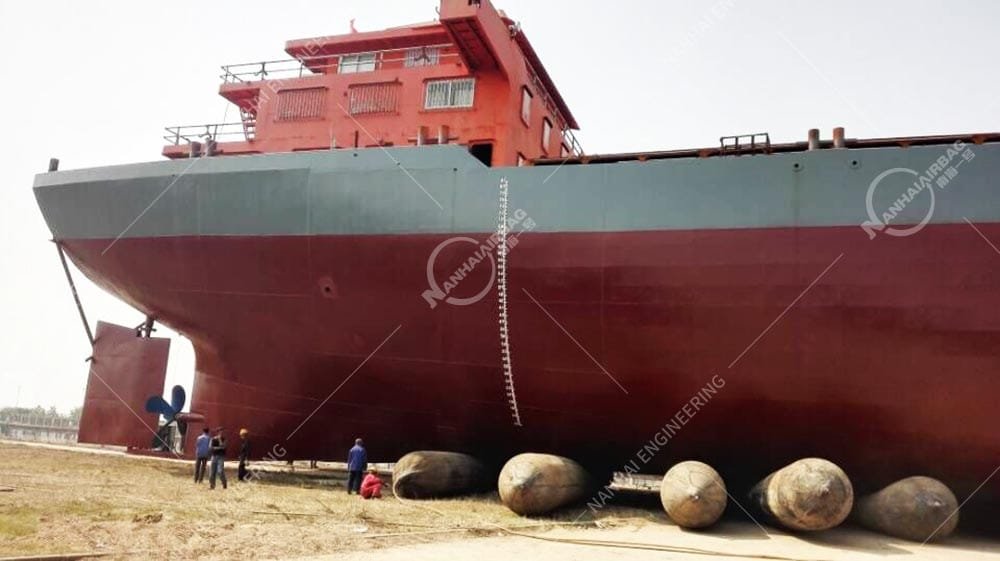Will a foam fender still work if it has cuts or dents?
08/08/2025Can I add a tire net to the existing pneumatic fenders?
08/12/2025How do I prevent ship launching airbags failure?
Have you ever been to a shipyard and seen those huge, round black airbags holding a vessel—whether a few tons or up to a hundred thousand tons—steady on the water?
They are called ship launching airbags, the “behind-the-scenes heroes” of ship launching. Don’t be fooled by how tough they look—if used the wrong way, they can suddenly leak, burst, or even cause the entire launch to fail.
At NANHAI, a supplier with years of experience in marine airbags, we know how serious a failure can be. Today, let’s discuss how to use these airbags properly, prevent accidents, and ensure a smooth launch that is both safe and secure.

1. What Ship Launching Airbags Do
Simply put, ship launching airbags are “inflatable cushions” that help vessels slide into the water. Compared to traditional slipways, they are cheaper, more flexible to install, and can handle different ship sizes and weights. NANHAI airbags are made with high-strength rubber and multiple layers of tire cord, giving them both compression resistance and heavy load capacity. They have already been used in shipyards worldwide.
2. Common Causes of Airbag Problems
- Poor materials
If the rubber and reinforcement layers don’t meet standards, they can be crushed or torn easily. - Overloading
If the water level is too low, the airbags bear extra weight, which could cause them to burst. - Unstable installation
An uneven or weak slipway or poorly secured ropes can lead to uneven pressure on the airbags. - Lack of maintenance
Scratches from sharp objects, cracks on the surface, or humid storage conditions speed up aging.
3. How to Prevent Airbag Failure
1. Start with Top Quality
- Use high-strength, tear-resistant materials. NANHAI airbags are made with strictly selected and tested raw materials.
- Apply an integrated woven structure to avoid weak seams.
- Test each airbag for airtightness and bursting pressure—must reach at least 3× the rated working pressure. All NANHAI models exceed ISO 17357 standards.
2. Install the Right Way
- Calculate the correct number and placement of airbags. Common layouts include straight, staggered, and double-row.
- Ensure the slipway is flat, solid, and can handle at least twice the airbag’s working pressure.
- Use NANHAI’s professional ropes, pulleys, and winch systems to ensure safe and reliable operation.
3. Maintain Regularly
- Check the surface for cracks or cuts before each use.
- After use, rinse clean, dry completely, and apply talcum powder to slow aging.
- Store in a cool, dry place away from chemicals and direct sunlight.
- After 5–8 years, conduct a full inspection; replace severely aged airbags in time.
4. Prepare for Emergencies
- Assess risks before launch—friction, vessel stability, tonnage, etc.
- Keep spare airbags ready in case of sudden leaks.
- Have an emergency stop plan and ensure the crew has practice experience.
FAQ
Q1: How long can an airbag last?
Usually 5–8 years, if well maintained. NANHAI provides regular inspection and maintenance advice.
Q2: Can airbags suddenly burst?
Not if they are high quality and used correctly. Bursting pressure is at least 3× the working pressure.
Q3: How do I know how many airbags to use?
Calculate based on the ship’s weight and size. Follow ISO standards or contact NANHAI for a design plan.
Q4: What are the slipway requirements?
Flat, stable, and strong—ideally with load capacity over twice the airbag’s working pressure.
Q5: How should airbags be stored?
Clean, dry, apply talcum powder, store in a cool, dry place, away from sunlight and chemicals.
Final Thoughts
Ship launching airbags may look like giant “balloons,” but they are vital to a safe vessel launch. NANHAI is committed to high-quality design and production, providing reliable and safe launching solutions for customers worldwide. Choose well, use correctly, and maintain regularly—and these airbags will safely send your ship into the water, time after time.
